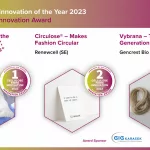A Report on the International Conference organised by
Euratex and the European Textile Technology Platform in Brussels
The international conference “Innovation for textile resource efficiency – energy, water & materials” took place on 22 November in Brussels. It brought together experts from industry, the research and technology sector and EU policy makers. The event was coorganised by EURATEX, the European Apparel and Textile Confederation and the European Technology Platform for the Future of Textiles and Clothing, Europe’s largest expert network in the field of textile research and innovation.
The objective of the event was to explore the key policy, market and technology drivers for resource efficiency, the major needs and challenges faced by companies across Europe, technological and non-technological innovation enablers as well as support policies and programmes provided by the European Union. The conference was structured in 3 plenary sessions (opening & policy issues, industry issues and wrap-up session) and 3 parallel sessions dealing respectively with the main types of resources – energy, water and materials.

Speakers of the opening session (from left to right) : Antoine Peeters, EuropaBio; Francesco Marchi, Euratex; Paolo Canonico, Textile ETP chairman; Julio Cardoso, European Commission; Loredana Ghinea, a.SPIRE
Many speakers made it clear that constantly rising resource utilisation costs, tightening environmental legislation and seriously emerging market requirements for more sustainable products constantly push companies (1) to do more with less, (2) to use and re-use resources in multiple cycles and (3) to better measure, monitor and communicate their resource efficiency.

Speakers of the industry panel (from left to right) : Fredrik Johansson, FOV Fabrics ; Rudi Daelmans, Desso ; Bertram Rollmann, Pirin-Tex, Francesco Marchi, Euratex; Regina Brückner, Brückner Trockentechnik
Major challenges for industry include :
- The difficulty to invest in resource efficiency solutions in the face of resource price volatility and unpredictable market and policy changes;
- The lack of in-house competences of companies, especially SME’s, to optimise existing processes for a perfect combination of productivity, quality and resource efficiency;
- A holistic resource optimisation along the complete value chain from raw material to final product as opposed to a single process step optimisation;
- The lack of innovative technology solutions that address European industry’s needs for efficient short lead time, highly flexible, short run/small batch production;
- The lack of capacities to invest large scale in new technologies coupled with still limited industry readiness of some potential breakthrough technologies;
- The need for sound sustainability criteria and related management and communication tools to better distinguish truly resource efficient solutions from mere “greenwash”.
However, various speakers provided numerous ideas and concrete practical examples for resource efficiency measures that are accessible for many companies and can bring quick rewards. These included :
- Simple measuring and monitoring systems that provide the basic information to identify the greatest resource consumers in the production to be attacked first;
- Various practical concepts to increase water efficiency in wet textile processing or to valorise excess heat from different processes;
- Ideas to collect and valorise production waste materials or to recycle certain post-consumer products based on existing technologies.
 Among the more strategic, medium to long-term opportunities the following were also highlighted :
Among the more strategic, medium to long-term opportunities the following were also highlighted :
- Development to full industry maturity of various dry or low-water energy efficient textile processing technologies;
- The development of textile wet processes including an appropriate (bio)chemistry enabling closed water cycles and a near complete recovery of processing chemicals;
- Establishment of effective European post-use textile collection, sorting and recycling systems starting in professional markets (carpets, workwear, technical textiles) later extended to post-consumer markets;
- Introduction of full cradle-to-cradle textile concepts with products designed for easy recycling to ensure closed material cycles;
- Large-scale adoption of bio-polymer and other sustainable biomass based fibres as major raw material source for the European textile industry.





